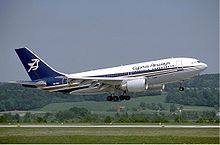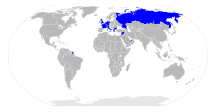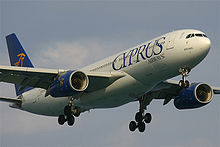- Cyprus Airways
-
Cyprus Airways
Κυπριακές Αερογραμμές
IATA
CYICAO
CYPCallsign
CYPRUSFounded 1947 Hubs Focus cities Frequent-flyer program SunMiles Airport lounge Executive Lounge Fleet size 13 Destinations 41 Company slogan We Understand Why You Fly >>> Parent company Government of Cyprus Headquarters Nicosia, Cyprus Key people George Mavrocostas (CEO) Website www.cyprusair.com Cyprus Airways (Greek: Κυπριακές Αερογραμμές, Kypriakés Aerogrammés - CY) is the national airline of Cyprus, a public limited company with its head offices located in the capital of the island, Nicosia.[1] It operates scheduled services to 41 destinations in Europe, the Middle East and the Gulf. It flies from both airports of the island, Larnaca and Paphos, with the former serving as a hub. The airline also operates fifth freedom flights from Thessaloniki to Paris. The airline celebrated its 60th anniversary in 2007.
Contents
History
Early Years
The airline was established on 24 September 1947 as a joint venture between the colonial government of Cyprus, BEA (British European Airways), and private interests. Operations commenced on 18 April 1948 with three Douglas DC-3 aircraft.The planes, which carried 21 passengers each, flew on a route network centered in Nicosia that soon included Rome, London (via Athens), Beirut, Athens, Cairo, Istanbul, and Haifa. During the next three years the airline purchased an additional three DC-3 aircraft and introduced new services to Alexandria, Amman, Bahrain, Khartoum (via Haifa) and Lydda.
In 1952, BEA took over service to London with an Airspeed Ambassador, which featured Cabin pressurisation that allowed nonstop routing avoiding a stopover in Athens. On 18 April 1953, BEA commenced using its newly delivered Vickers Viscount 701 on their scheduled service from London to Rome and Athens. The continuing sector from Athens to Nicosia was operated by BEA under charter to Cyprus Airways. This route from London to Nicosia was the world's first regular turboprop service.[2]
In 1956, contemplating expansion of its routes, the company ordered two Vickers Viscount 756 aircraft that would be named St Hilarion (registration G-APCD) and Buffavento (G-APCE), but eventually it decided to sell them before receiving them because of the uncertain political situation in Cyprus. It also decided to sell all the Douglas DC-3 and Auster aircraft in September 1957 and enter into a five-year agreement with BEA for the latter to operate services on behalf of Cyprus Airways.[3]
BEA took over the operation of all Cyprus Airways services effective 26 January 1958 by special arrangement.
Independence in 1960
The government of newly independent Cyprus became the majority shareholder in 1960 with a 53.2 percent holding, while BEA's stake was reduced to 22.7 percent and private individuals held the rest. Thereafter, Cypriot nationals began to be hired and trained for the flight crews, which had previously been made up of British expatriates from BEA.
Cyprus Airways still relied on the U.K. airline for aircraft. BEA began introducing Comet 4B jets on all routes in 1961 via a joint aircraft pool arrangement that included Greece's Olympic Airways.
On 5 April 1960, BEA introduced de Havilland Comet 4B aircraft on the Nicosia, Athens, Rome, and London routes. Cyprus Airways with the introduction of the Comets became the first airline in the middle east to have jet airplanes. The Comets flew in the BEA livery, but had the Cyprus Airways logo and title affixed above their doors.
In 1965, Cyprus began leasing its own Viscounts from BEA for regional routes. Around this time, a winged mountain goat, the flying mouflon, was adopted for the airline's logo.
The Comet and Viscount aircraft were replaced with five Trident jets three of them acquired from BEA. The first Hawker Siddeley Trident jet was introduced in September 1969. Cyprus also leased a BAC 1-11. The faster planes allowed more European trade centres (Frankfurt, Manchester, Brussels, and Paris) to be added to the timetable.
1974
At the start of the Turkish invasion of Cyprus in 1974, the attack on Nicosia airport caught all five of Cyprus Airways aircraft on the ground. Of the four Tridents stranded at Nicosia International Airport.,[4] one was destroyed by Turkish Air force rocket fire and wreckage of its tail still exists at that airport and one was damaged by small arms fire remaining in the same position today as it did in 1974 slowly decaying. The two other Tridents were only lightly damaged by small arms fire and were flown out of Nicosia by British Airways engineers to the United Kingdom in 1977. One of these is now on display at the Imperial War Museum Duxford, England, although it has been returned to its original BEA livery.[5] Also flown out was the company's BAC1-11 which was claimed by the insurers of the lessor, Court-Line, which had gone bankrupt. That aircraft returned to Cyprus Airways in 1978 and served with the company until 1995.
All of the Cypriot airline's operations had to be suspended following the end of the hostilities in 1974 because the Nicosia International Airport, the only airport of the island, had to be closed. Although the Turkish troops had failed to capture it, they were close enough to it to demand that it not be reopened. The government of Cyprus then moved quickly to build a small terminal by a runway in Larnaca and Cyprus Airways restarted limited operations from there on 8 February 1975.The airline leased Viscount turboprops to fly a stripped down route network to a few key cities in the region: Beirut, Tel Aviv, and Athens via Heraklion, with connections to London on British Airways. Cyprus Airways leased a pair of DC-9 jets in August 1975 to resume its own flights to London (via Salonika). The acquisition of a DC-8 several months later allowed for non-stop service. Cyprus also added flights to Saudi Arabia at this time. The company was soon able to order a pair of new BAC 1-11s, added to the sister aircraft already in the fleet.The economic loss of the Turkish invasion to the airline was estimated to be 1.6 million Cypriot pounds.The airline to survive decided to reduce the salaries of all its employees to minimum who proudly accepted it.
The airline ordered still more different aircraft types in the late 1970s which replaced some earlier aircraft coming off lease.
Expansion in the 1980s
 Airbus A310-200 of Cyprus Airways at Zurich Airport in 1985
Airbus A310-200 of Cyprus Airways at Zurich Airport in 1985
By 1981, Cyprus's fleet included four Boeing 707-123B (1979–1989) and three BAC One-Eleven 500. The route network again extended from Manchester, England, to Baghdad. A change in ownership structure had taken place, with British Airways selling all but 5 percent of the shares it had inherited from BEA to the Cypriot government. Private investors owned the remainder (24.14 percent).
Cyprus made a transition to Airbus aircraft over the course of the decade. Its first A310 widebodies arrived in 1984, followed by A320s in 1989. The order for the eight A320s was worth more than DEM 250 million.
Cyprus Airways was one of the first airlines to operate the Airbus A310, the eighth airline in the world to receive the Airbus A320, and the first airline that launched the IAE V2500 engine along with Adria Airways.
Profits reached record levels in the mid-1980s as the airline added service from new U.K. cities (Cardiff, Newcastle, and Glasgow). Income of CYP 4.8 million (DEM 8 million) in 1983, a record, would be tripled three years later. By this time, the airline was carrying 740,000 passengers a year.
1990s
 Cyprus Airways Airbus A310 departing Manchester Airport for Larnaca in 1991
Cyprus Airways Airbus A310 departing Manchester Airport for Larnaca in 1991
British Airways divested the last of its shares in 1991, leaving the government with an 80.46 percent stake and private investors, the remainder. The airline was flying high, introducing a livery and uniforms as the Airbuses plied new routes to Berlin and Helsinki. Cyprus Airways had also joined the SABRE international computer reservations system and set up a tour operation in the United Kingdom.
In 1992 the group established Eurocypria Airlines Ltd. to fly European tourists to Cyprus on a charter basis. It was expanding into ancillary services as well, taking over duty-free operations at Larnaca and Pafos airports.
Cyprus added many new cooperation agreements with other airlines as it developed its international reach by linking Europe and the Middle East. Its partners included KLM and Saudia. By the mid-1990s, more than one million passengers were flying Cyprus Airways every year; another 4,000 chose the charter operation Eurocypria. The airline's market share approached 40 percent. After a rough couple of years, the company posted a CYP 13 million profit in 1994 thanks to cost-cutting and marketing efforts.
New Millennium
The airline introduced a restyled livery, as it embarked on an ambitious fleet renewal programme. Two new Airbus A319s, smaller than its other aircraft, were added in 2002. The next year, two new Airbus A330s replaced the older A310s on long-haul routes. A fleet of four Boeing 737s was chosen for the Eurocypria charter subsidiary, however, with two further similar aircraft added in 2004 and 2005. A feature of the new Eurocypria aircraft was that each had a different colour on its tail. In the meantime, the A320s owned by Cyprus Airways but leased to Eurocypria were returned to the parent company.
In 2002, the Cypriot government lowered its ownership stake to 69.62 percent.
Cyprus Airways founded Hellas Jet in Athens (Greece) in 2003, never making a profit. It held a 75% share of that carrier until all of the shares were sold to Air Miles in 2005.
In 2006, the government of Cyprus bought Eurocypria because Cyprus Airways started facing severe financial problems.
According to the airline's 2010 financial results the operating loss for 2010 was €4,9 million in comparison to a loss of €5,4 million in 2009.[6] On 28 June 2011 Cyprus Airways issued a profits warning to the Cyprus Stock Exchange, attributing this to "the continuing financial crisis and to the further significant increase in fuel prices."[7] On 31 August 2011 Cyprus Airways issued its results for the first half of 2011 which showed a loss of €29,3 million in comparison to a loss of €25,5 million for the respective period of 2010, recording an increase of €3,8 million.[8]
As of July 25, Cyprus Airways has signed a code-share agreement with Virgin Atlantic Airways. The Cypriot market will be able to travel to Boston, New York and Los Angeles on behalf of Virgin, with connecting flights at London Heathrow Airport. Passengers will fly from Cyprus to London, and then from London to the new American destinatons on Virgin. Virgin will also code-share flights between London and Larnaca on behalf of Cyprus Airways.
Present
Cyprus Airways is owned by the government of Cyprus (69.62%) and private shareholders (30.38%) and has 1,210 employees (October 2010).[9]
Destinations
Main article: Cyprus Airways destinationsCyprus Airways serves 41 destinations in 15 countries in two continents. As a part of the code-share agreement between Cyprus Airways and Olympic Air, Cyprus Airways shares the routes to some of the Greek island with Olympic Air.
Cyprus Airways has codeshare agreements with the following airlines:
- Aeroflot (SkyTeam)
- Alitalia (SkyTeam)
- Etihad Airways
- Gulf Air
- KLM (SkyTeam)
- Olympic Air
- Syrian Air
- TAROM (SkyTeam)
- Virgin Atlantic
Fleet
Cyprus airways' airplane landing in Manchester Airport (2009)
As of July 2011, the Cyprus Airways fleet consists of the following aircraft with an average age of 7.9 years:[10][11]
Aircraft In Service On Order Passengers Notes J Y Total Airbus A319-100 4 0 12 114 126 1 leased from Agrind Lease Ltd
2 leased from ILFCAirbus A320-200 6
10 20
16132
146152[12]
162[12]6 leased from CIT Airbus A321-200 0 2 Unknown Unknown Unknown To be leased from CIT Airbus A330-200 2 0 30 265 295 Leased from ILFC - To be phased out by January 2012[12] Total 13 2  A Cyprus Airways Airbus A320 landing at London Heathrow Airport in August 2004.
A Cyprus Airways Airbus A320 landing at London Heathrow Airport in August 2004.
All of Cyprus Airways aircraft bear names of important persons from the island's ancient history, Greek mythology, or cities either modern or ancient.[13]
On September 1, 2011, Cyprus Airways announced they would be returning both their A330 aircraft to the lessor in December 2011 and January 2012 consecutively to reduced losses. They will be replaced by two leased A321-200 aircraft, arriving in the fleet in April and May 2012.
Past Fleet
- 7 x Airbus A320 (1989–2011) - This type has not been phased out from the fleet, but the original aircraft, except one, were replaced by the current new A320s.
- 4 x Airbus A310 (1984–2004)
- 2 x Airspeed Oxford[3] (1953–1955)
- 2 x Airspeed Ambassador
- 2 x Auster Alpine[14]
- 3 x BAC One-Eleven 500
- 5 x Boeing 707-123B (1979–1989)
- 4 x Boeing 720 (1976–1979)
- Bristol Britannia 253
- 1 x Canadair CL44 D4-1 Freighter
- De Havilland Comet
- 6 x Douglas DC-3 Dakota (operated between 1947-1957 named Salamis, Amathus, Citium, Curium, Alasia and Paphos)
- Douglas DC-6B Freighter
- Douglas DC-8-52
- Douglas DC-9-15
- 2 x Hawker Siddeley Trident 1E
- 3 x Hawker Siddeley Trident 2E
- Vickers Viscount 806
Livery
The airline's livery is an all white fuselage with the words 'CYPRUS AIRWAYS' in blue over the front passenger windows. The vertical stabilizer is blue with a number of yellow lines depicting a galloping Cypriot mouflon, a type of sheep only found in Cyprus. This logo is also painted on the engines of the aircraft.
Services
Catering
Food and beverages served on flights from Cyprus are provided by Cyprus Airways Catering facilities in Larnaca. Meals are selected of an array of International and Cyprus tastes.
In-flight entertainment
Cyprus Airways in-flight entertainment system is equipped with personal TVs (PTVs) in every seat in the Airbus A330 aircraft.In the Airbus A320 larger screens averaging for a number of passengers are placed in an even distance along the aircraft so everyone can have a clear view and the sound is provided through personal headsets given by the cabin crew. Screens have a moving-map system which provides real-time flight information such position and direction of the plane,altitude,airspeed,distance to destination, distance from origination and local time.
Business Class
Business Class is named after the ancient Greek god Apollo who was a symbol of harmony, order, and reason. Apollo class has wide leather seats that recline by up to 45 in (110 cm) of pitch and feature electrical recline and leg rest. Apollo class passengers also have access to the Sunjet executive lounges at both Larnaca and Paphos airports.
The Business Class of Cyprus Airways includes a personal entertainment system, built into the armrest of the high standard seats. Additionally, meals are served to business class passengers, with a selection of international and Cypriot cuisine on offer. Moreover, there is an array of drinks and selected wines on offer on all flights.
Economy Class
Economy Class is named after the ancient Greek goddess Aphrodite who according to Greek mythology, was born of the shores of paphos on the island of Cyprus and was a symbol of beauty, elegance, sex and love. Cyprus Airways' Aphrodite (economy) Class offers a seat pitch of 30-31 inches on short-haul aircraft and 31-32 inches on the long-haul Airbus A330.
Depending on the destination and time you are flying, a hot breakfast, lunch or cold snack is served. The tray includes a seasonal salad and dessert, as well as crackers and cheese. A selection of complimentary drinks, including coffee or tea and soft drinks will also be offered.
SunMiles
SunMiles is the frequent flyer programme of Cyprus Airways. There are four tiers of membership: Student, Regular, Premier, and Elite. Points are organisely credited per each one way flight on Cyprus airways. Economy class passenger gains 1 point per kiliometre and Business class passenger gains 1,5 points per kiliometre.
Awards
Cyprus Airways has been awarded the ‘Commitment to Excellence in Europe’ award by the European Foundation of Quality Management (EFQM) in 2007.
Cyprus Airways was also awarded the 'IATA Best In-flight Programming for a European airline' award.
Incidents
In 1967, Cyprus Airways Flight 284 broke up in midair on a flight between Athens and Nicosia most likely as a result of the detonation of an explosive device, with the loss of 66 lives. The de Havilland Comet was owned and operated by British European Airways (BEA) although cabin staff were Cyprus Airways employees.
References
- ^ "Addresses." Cyprus Airways. Retrieved on 6 November 2009. "Addresses Cyprus Airways Public Limited 21 Alkeou street, P.O. Box 21903 CY - 2404 Engomi, Nicosia, Cyprus"
- ^ Stroud, John, Annals of British and Commonwealth Air Transport, 1962, Putnam, page 452
- ^ a b Air Pictorial June 1970
- ^ Air Pictorial July 1977
- ^ Duxford Aviation Society website: http://www.das.org.uk/trident.htm
- ^ http://cyprusair.com/data/files/financial_information/CYfinfeb11en.doc
- ^ http://cyprusair.com/893,1,0,4445,1437,2-default.aspx
- ^ http://cyprusair.com/data/files/Interim2011En-results.doc
- ^ "Merger planned for two financially troubled Cyprus airlines". 2010-09-13. http://atwonline.com/international-aviation-regulation/news/merger-planned-two-financially-troubled-cyprus-airlines-0912. Retrieved 2010-09-13.
- ^ Cyprus Airways Fleet
- ^ Cyprus Airways Fleet (Official)
- ^ a b c http://cyprusair.com/data/EnPtisi/CYPRYSAIR%201%20indd_pdf.pdf
- ^ http://www.planespotters.net/Production_List/Airbus/A320/4197,5B-DCG-Cyprus-Airways.php
- ^ www.flightglobal.com
External links
Airlines of Cyprus Cyprus Airways · Eurocypria Airlines
Defunct airlines shown in italicsMembers of the Association of European Airlines Adria Airways · Aegean Airlines · Aerosvit · airBaltic · Air France · Air Malta · Alitalia · Austrian Airlines · BMI · British Airways · Brussels Airlines · Cargolux · Croatia Airlines · Cyprus Airways · Czech Airlines · European Air Transport · Finnair · Iberia Airlines · Icelandair · Jat Airways · KLM · LOT Polish Airlines · Lufthansa · Luxair · Malév Hungarian Airlines · Montenegro Airlines · Olympic Air · Scandinavian Airlines · Swiss International Air Lines · TAP Portugal · TAROM · TNT Airways · Turkish Airlines · Ukraine International Airlines · Virgin Atlantic Airways
Categories:- Airlines of Cyprus
- IATA members
- Association of European Airlines members
- Airlines established in 1947
- Government-owned airlines
Wikimedia Foundation. 2010.





